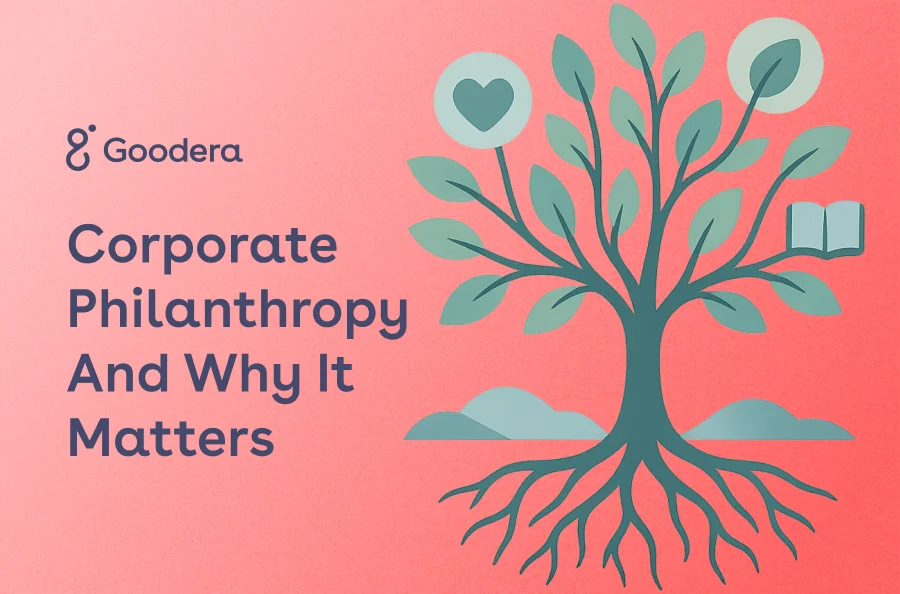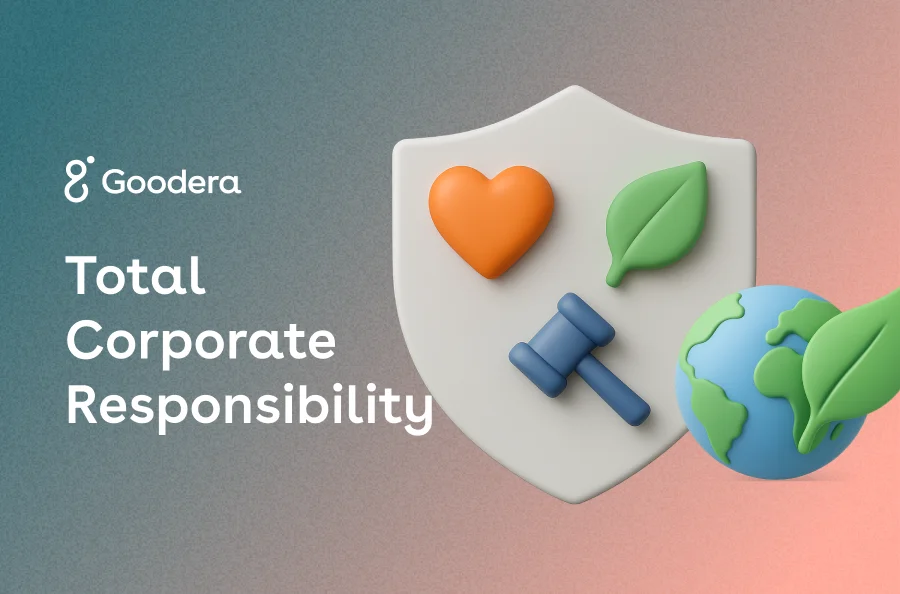The Strategy of Corporate Social Responsibility: A Complete Guide for 2025
If you’re here, you’re probably asking the same question every company is grappling with right now: What does meaningful CSR look like in 2025? Because the role of Corporate Social Responsibility has changed. It’s no longer a PR line or a compliance exercise; it’s a signal of who you are as a business—and whether people can trust you.
Employees feel this deeply. Communities feel it. Even customers make decisions based on it. Which means a strong CSR strategy isn’t just “nice to have” anymore; it’s part of how companies stay relevant, credible, and worth believing in.
And the good news? When CSR is built with intention, it becomes one of the most powerful levers for culture, engagement, and long-term impact.
Let’s start with where we are today.
CSR is now an expectation, not an option. In 2024, 99 percent of S&P 500 companies published a CSR or sustainability report, and 98 percent continued to do the same in 2025. That’s practically every major company staking a claim on their values and impact. And employees are paying attention: recent studies show that about 90 percent of millennials want to work for companies that share their values and have a clear social purpose.
That’s a massive shift from even a few years ago.
People want meaningful work. Companies want engaged teams. Communities want long-term partners. CSR sits right at the center of all three.
So why does having a real CSR strategy matter so much today?
Because when CSR is treated like a checkbox, everyone can tell. But when it becomes part of your culture, part of how you make decisions, show up for communities, and create space for employees to contribute, things start to move. Engagement goes up. Retention strengthens. Customer trust deepens. Even innovation grows because people feel connected to something bigger.
Goodera’s Volunteer Quotient Report backs this up, showing that companies with structured CSR programs see significantly higher participation and year-round involvement.
This guide is here to make all of that easier. Think of it as your step-by-step walkthrough of how purpose and business can work together in a way that feels real, measurable, and long-lasting.
Along the way, we’ll talk about:
- What social responsibility strategies actually are
- How to weave CSR into your culture and planning
- The steps to build a CSR strategy from scratch
- How to get leadership, employees, and partners excited about the journey
- Examples of companies that are doing this well (and what you can learn from them)
What are Social Responsibility Strategies
At its core, a social responsibility strategy is your company’s blueprint for how it shows up in the world. It’s the plan that guides how you operate ethically, support communities, protect the planet, and create long-term value for the people who rely on you.
But here’s the real question most companies fail to ask:
How do you turn “we care about impact” into an actual strategy people can believe in?
It begins with understanding the four pillars that shape the relationship between corporate social responsibility and strategy. These pillars are lenses through which your business decisions gain meaning, transparency, and accountability.
The Four Pillars of CSR Strategy

1. Environmental Responsibility
This pillar is about how a business interacts with the planet. It goes far beyond recycling bins and tree-planting campaigns. It’s about rethinking operations to reduce carbon emissions, adopting renewable energy, designing sustainable supply chains, and minimizing waste wherever possible.
For instance, companies like Google have made carbon neutrality a cornerstone of their operations since 2007 and are now moving toward a net-zero future by 2030, showing that environmental responsibility can be deeply integrated into business strategy. Other businesses are redesigning packaging, sourcing sustainably, and funding environmental restoration programs, turning everyday operations into meaningful, measurable impact.
2. Ethical Responsibility
Ethical responsibility focuses on how a company treats the people and partners it works with. It’s about fairness, integrity, and transparency in every decision. This shows up in enforcing fair labor practices across the supply chain, ensuring diversity and inclusion in hiring and promotions, and maintaining transparent governance.
The Body Shop, for instance, has long built its reputation on fair trade and ethical sourcing, showing how ethics can be a core differentiator and a magnet for trust. When employees know their company is committed to ethical behavior, engagement improves, and talent is more likely to stay and thrive.
3. Philanthropic Responsibility
Philanthropy is often the most visible face of CSR, but it’s also evolving. Giving back today isn’t just about writing a check; it’s about creating meaningful, long-term partnerships that amplify impact. This can include volunteer programs, skills-based initiatives, and targeted support for causes like education, healthcare, and social justice. Many companies have adapted to new ways of giving, from remote volunteer opportunities to collaborative projects with nonprofits, ensuring employees can contribute even when working remotely. Philanthropic CSR bridges the gap between a company and its communities, building goodwill while driving real social change.
4. Economic Responsibility
Economic responsibility integrates purpose with profit. It’s about generating value in ways that benefit both the business and the broader ecosystem. This can take the form of hiring locally, supporting small businesses, investing in underserved communities, or creating programs that enhance economic opportunity. Companies like Microsoft exemplify this by investing in digital literacy and workforce development programs, creating lasting social and economic impact alongside business growth..
When these four pillars are intentionally combined, a CSR strategy becomes more than a collection of isolated initiatives. It signals to employees, investors, customers, and communities that social responsibility is embedded in how the business operates, not a side project. Organizations that align these pillars with their core objectives often see stronger employee participation, greater engagement, and long-term trust, because every action is part of a cohesive, purpose-driven strategy.
Learn more about the Types of Corporate Social Responsibility.
Why These Pillars Matter in 2025
When companies build their CSR strategy on these four pillars, something shifts internally and externally. Employees begin to believe the work has purpose. Communities start to see the company as a partner, not just a brand.
When CSR is built on the four pillars, leaders get a clear structure for how to make decisions, allocate resources, choose initiatives, and measure impact. Without that structure, CSR can feel like a series of random activities that look good on paper but don't actually change anything—something done for optics.
Recent 2025 data backs this up. Companies with strong ESG and CSR programs report higher employee satisfaction, with purpose-driven organizations seeing up to 14 percent higher satisfaction scores. It matters even more for the next generation, with 40 percent of millennials and Gen Z preferring to work for companies that connect sustainability to business goals.
All of this reinforces a simple truth: CSR works best when it is part of your strategy, not your side project.
When these four pillars guide your decision-making, your efforts become easier to sustain, easier to measure, and far more inspiring for your teams. Over time, your CSR program stops being something the company does and becomes part of your culture, identity, and everyday operations.
Why Every Business Needs a Corporate Social Responsibility Strategy
A well-developed corporate social responsibility strategy helps companies create long-term value for both stakeholders and society. It strengthens reputation, drives employee engagement, and builds trust among consumers who increasingly prefer ethical brands.
A recent Deloitte research shows that consumers are becoming far more intentional about where they spend their money. Over one-third of people worldwide say they would pay more for products from companies that support environmental or social causes, and about 40 percent factor sustainability into their buying decisions. For businesses, this signals a clear shift: CSR is no longer just a positive add-on, it is quickly becoming a real advantage in the market.
CSR also helps organizations future-proof themselves. Integrating sustainability, ethics, and social impact into core operations positions a brand as resilient and forward-looking.
How to Develop an Effective Strategy of Corporate Social Responsibility
Developing a CSR strategy requires a well-formulated plan. It involves researching, collecting facts and figures, making decisions, bringing people on board, and many other responsibilities. Read along to learn a step-by-step process to build a successful Corporate Social Responsibility strategy.
1. Research and Define Your CSR Plan
Developing a CSR program begins with deep research about environmental, social, and governance issues. Start by recognizing the general issues in the economy. You can network with non-profit agencies, NGOs, and HR professionals to collect real-time data on the problems. If your CSR strategy aligns with working for human resource causes, you can start by researching what your employees care about and the issues they face. After collecting the data, you can refine it by shredding excess information and retaining only the chunk that explains your CSR goals.
You can define your goal precisely by looking into current CSR trends. Another good place to research is the list of 17 Sustainable Development Goals of the United Nations.
Related: Top Corporate Social Responsibility Ideas &Initiatives
2. Strategize the campaign
After conducting adequate research, synthesize the entire plan into a series of strategies. These strategies should be goal-driven and pragmatic. Set realistic and achievable goals for the short, medium, and long term. Make sure to aim for the purposes that are relevant to your business.
For example, if your company is an NBFC, your CSR strategy could include funding scholarships to CFA candidates. Similarly, if your company is responsible for generating an excessive carbon footprint, you can set goals to create environmental equilibrium.
For instance, Google has been carbon-neutral since 2007 and has aimed to become carbon-free by 2030. It has also pledged to achieve zero net emissions from its value chain activities. Creating a strategy that reflects your company's values and culture results in higher employee engagement and greater stakeholder trust.

3. Establish the CSR Framework
Once you finish strategizing your goals, you can move on to designing a functional framework for the company to take action. You can start by exploring opportunities that require a social commitment. Ensure that the opportunities you look for are relevant to your business objectives.
For example, LEGO dedicated the "Build the Change" initiative to empowering children and bringing out their creativity. Your goals do not have to imitate other companies' CSR strategies. You must look for the right opportunity and pledge to create a noteworthy difference.

4. Make Sure To Have a Face of the Campaign
Having a corporate social responsibility program backed by the company's executives directly translates into a sense of importance created in the minds of its stakeholders. An executive buy-in adds commitment and dedication to the corporate social responsibility program.
Employees get motivated to take charge of their responsibilities, and investors develop trust in the organization. To get the leaders on board, educate them about your research-based strategy and how it aligns with the brand's vision. Explain the benefit it will bring to your organization in the long run. You can even incorporate insights from other brands implementing CSR strategies and demonstrate their outcomes.
5. Launch the Campaign
After putting in all the research and formulating an executable plan, it's time to launch the campaign. Design presentations to inform stakeholders about the company's strategies and goals, ensuring they are aware of the program. Clearly communicate your program to your employees, investors, customers, clients, and followers. Maintain transparency by releasing public data that displays facts and figures about the program's statistics. For example, since 2015, Google has published its annual environmental report, presenting data on goals aimed at, achieved, and in progress.
6. Follow up and stay connected
Build good relationships with the community and incorporate empathy as a brand. The corporate social responsibility program is solely a means to make this world a better place through authentic and research-driven strategies.
This was a step-by-step guide demonstrating the process of developing a successful Corporate Social Responsibility strategy. Remember that every brand should design a strategy aligned with its values. It should be a customized plan and not a one-size-fits-all blueprint. Avoid expecting quick results. Even though you may notice short-term effects, CSR is a long-term strategy. It requires aggressive planning and execution to make a noticeable difference in the community.
Final Thoughts
Building a meaningful CSR strategy isn’t about finding the perfect template. It’s about choosing the version of responsibility that feels honest for your company and staying committed to it over time. The organizations that do this well aren’t the ones with the biggest budgets; they are the ones that show up consistently, listen to their employees and communities, and evolve as the world changes.
If there’s one thing 2025 has made clear, it’s that CSR is now part of how companies earn trust. Not through glossy reports or big announcements, but through intentional actions that line up with their values.
And that’s the opportunity ahead of you.
Start with clear pillars. Build programs people can believe in. Keep your leadership involved. Stay transparent about progress. And most importantly, make CSR a living part of your culture, not a task you revisit once a year.
When that happens, your strategy stops being a document and becomes a signal, to your employees, your partners, your customers, and your community, that your company is here to contribute, not just operate.
Purpose grows when you nurture it. Impact multiplies when you commit to it. Your CSR journey begins with choosing to do both.
Frequently Asked Questions About Corporate Social Responsibility and Strategy
What is a corporate responsibility strategy?
A corporate responsibility strategy is a structured plan that guides how a company incorporates ethical, social, and environmental priorities into its operations. It defines the company’s long-term commitments, the goals it wants to achieve, and the roadmap for implementing, managing, and measuring its impact across the business.
Is corporate social responsibility considered a business strategy?
Yes. CSR is a strategic framework that shapes how a company pursues growth while maintaining accountability to people and the planet. It influences decision-making, product development, community engagement, reporting practices, and long-term value creation.
How do companies use CSR to support business growth?
Companies use CSR to strengthen brand trust, improve employee engagement, attract socially conscious customers, and differentiate themselves in competitive markets. CSR-driven initiatives—such as sustainable product innovation or community partnerships—often open new opportunities, improve resilience, and support long-term business performance.
How do you write an effective CSR strategy?
Writing a strong CSR strategy includes:
- Identifying your company’s mission and aligning CSR priorities with it.
- Understanding stakeholder expectations, including employees, customers, investors, and community groups.
- Selecting focus areas such as environment, social impact, or ethical governance.
- Setting measurable goals and key performance indicators.
- Designing initiatives and programs that directly support those goals.
- Establishing ownership and accountability across teams.
- Communicating the strategy clearly to internal and external audiences.
- Tracking, reporting, and refining the strategy regularly based on outcomes.
What are the four main CSR focus areas?
The commonly recognized CSR pillars are:
- Environmental responsibility – Minimizing environmental footprint, improving sustainability practices, and conserving resources.
- Ethical responsibility – Ensuring fair business practices, transparent governance, and responsible sourcing.
- Philanthropic responsibility – Giving back through grants, volunteering, and partnerships with nonprofits.
- Economic responsibility – Operating in a way that supports long-term financial wellbeing for employees, communities, and shareholders.
What does CSR mean and what are some examples?
Corporate Social Responsibility refers to how companies consciously manage their impact on society and the environment. Examples include:
- Employee volunteering programs that support local communities.
- Reducing carbon emissions and improving resource efficiency.
- Ethical and transparent supply chain standards.
- Corporate giving programs, donations, and nonprofit partnerships.
- Community development initiatives, such as education or hunger relief programs.
CSR examples vary by company, but the core idea is contributing positively beyond business operations.
How do you incorporate social impact into corporate strategy?
You incorporate social impact into corporate strategy by identifying where your company’s strengths intersect with community needs, then embedding those priorities into planning, goal-setting, and decision-making. This includes choosing focus areas, setting measurable impact goals, aligning initiatives with business objectives, and ensuring cross-functional teams support the work. When social impact is built into strategy instead of sitting on the sidelines, it becomes easier to scale, measure, and sustain.
What are the best strategies to enhance corporate social responsibility efforts?
The best strategies to enhance CSR efforts focus on consistency, alignment, and participation. Companies strengthen CSR by integrating impact goals into company OKRs; forming long-term nonprofit partnerships; offering year-round employee volunteering; investing in strong measurement and reporting; and openly sharing outcomes with employees and customers. These strategies turn CSR from ad-hoc activities into a credible, high-impact part of the business.












